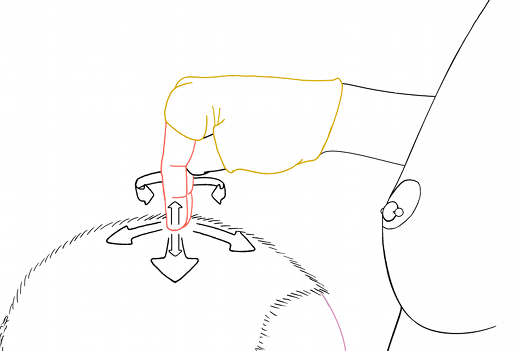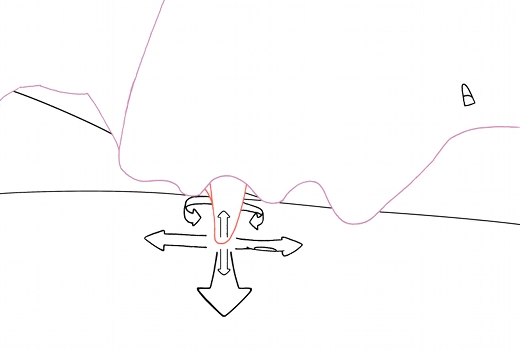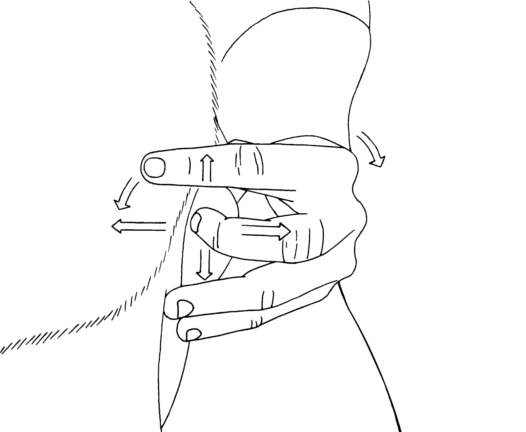

The right index and middle fingers may direct the change of the tongue's location.

As the right index and middle fingers stay in the same location, this may adjust where the tongue should start or be as tongue pressure is applied.
**As of 4/9/2022, knowledge of practical experience like the following thoughts is limited to actions like the directions of the tongue's location.** But it is known in protactile (PT) American Sign Language (ASL) group conversations of 3 people sitting side by side, there is an ability for the person sitting in the middle to relay signs from the person on one end to the person on the other end, with signing that looks ambidextrous and nearly simultaneous. In a PTASL dialogue, there are many circumstances, with uniquely developed terms called mapping, SASS, demonstration, and tactile imagery, where drawings are made on someone's body to describe witnessed locations, appearances, pressures, textures, and things (see Protactile Priciples by aj granda & Jelica Nuccio or videos from the Deafblind Interpreting National Training & Resource Center). PTASL is now a widely known language in the DeafBlind community that's about 13 years old, although about 3 in 10 DeafBlind interpreters surveyed use it (from the same institution, 2018). It is also noted in that report there are probably about 50,000 DeafBlind Americans.
Please try to understand these words about consent. Thank You
I. Basics
It is assumed both people in this have their right hand as their dominant or writing hand. This may work in the same way if they're both lefties or ambidextrous.
This activity depends on the principle of tactile message to tactile message dictation in a manner that is as close to synchronized as cognition allows. If POP to POP dictation works fluently, and if the speed, pressure, and location of writing can be appropriately articulated, and be accurately relayed, how may this practice be related or applied to finger motions that don't make text, but an oral stimulation of erogenous areas?
Instead of a message going from the OW's mind, to their right hand, to the RE's left hand, to their mind, to their right hand, to the OW's left hand, then back to their mind, the message may go from the OW's mind, to both of their hands, to the top of the RE's head, then, if their hair doesn't complicate reception, to the RE's mind, to their mouth, to the area of and around the OW's navel, back to the RE's head.


The right index and middle fingers may direct the change of the tongue's location.

As the right index and middle fingers stay in the same location, this may adjust where the tongue should start or be as tongue pressure is applied.
The OW and RE may agree on a point of reference on the top of the RE's head. This point may be represented by the OW's navel. Then they may agree on the representation of space. The OW, with their right index finger, from the point of reference, may very slowly illustrate the perimeter around this area on the RE's head. The RE would try to follow this path with their tongue. The OW would have their left hand clamping the RE's ear with their middle finger and thumb as the other fingers are against the scalp. While the ear is clamped, and the OW's right hand remains still, pulling the ear or pushing the RE's head in a certain direction may correct an off track tongue following. If this sense of space, and speed of understanding becomes fluent, the OW may increase the speed of their finger motions.
Slowly directing where these points of reference are and location changes can be made to some extent in less than 5 minutes of practice. More practice may allow more kinds of quicker responses from the RE.
VIII. Harmonious and holistic speed adjustment
IX. Recording and recalling memory
Nattali White was kind enough to offer a photo for reference, on the house.

This work is licensed under a Creative Commons Attribution-NonCommercial 4.0 International License.